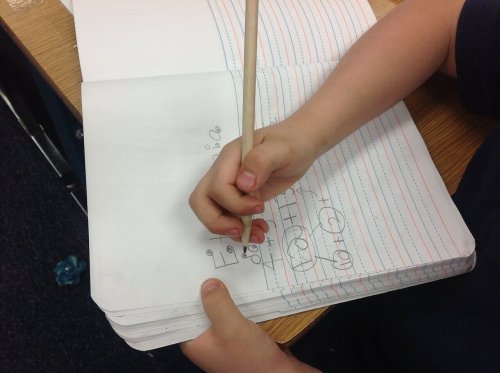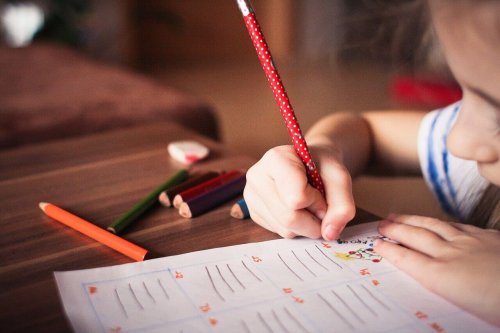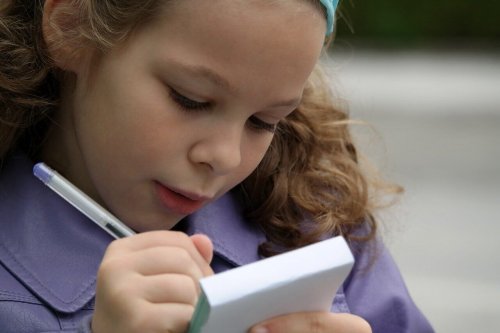Five Ways to Practice Spelling with Your Child

Learning to write and the rules do so “correctly” is one of the most complex stages that children go through. Therefore, you should practice spelling with your children at home and complement what they learn in school. This is a lot more fun if you get creative.
There’s seldom a family reunion in which a well-meaning family member won’t ask us or our school-age child if they already learned how to read and write, followed by a little test on “How do you spell your name?”
We’ll politely clench our teeth, fake a smile and say “Come on honey, we’ve practiced spelling your name many times. Remember? Here, let me help you.” (Ugh!)
If we feel pressured (and annoyed), just imagine the kind of anxiety children feel. They’re facing a new world of 26 new symbols and their infinite ways of combining them for the extensive written vocabulary they’ll once need to have – which also comes with all kinds of rules and conventions.
Following the Trail of Correct Writing

It’s not just about learning to read and write, but also about doing it correctly. Writing presupposes a new structure of reasoning for a child and a whole new way to communicate and express ideas.
However, this becomes more and more complex due to the fact that children are now exposed to the use of electronic devices and social networks. In the world of social media, spelling errors are becoming more common and are in fact being encouraged. (You don’t know what WTF means? ROFLMFAO!)
“Proper” spelling is lagging behind thanks to the number of characters allowed in a Twitter message…or by the rush to reply in a chat. Most of these platforms allow for “slip-ups” when writing, such as abbreviating words or obviating punctuation marks or even using “emoticons.”
All of this complicates and increases the challenge of teaching our children how to spell in the information age. However, the best way to learn to write correctly, to expand one’s vocabulary and to even learn a new language is simply through reading.
How to Practice Spelling with Your Child
It’s important to look for fun and creative ways to introduce children to the world of letters and practice spelling. Apart from what the school offers and the interaction with new technology, it’s necessary to make the practice of spelling a fun task, full of games and playful challenges.
1. Take Advantage of Technology
Leaving your children in front of a screen, mobile phone or a tablet puts some parents in a constant moral dilemma. New technology increasingly decreases quality family time and exposes children to elements that can’t be constantly monitored by adults.
However, on different platforms, you can also find great allies to make reading and writing a fun moment.
Just connect a few minutes and you can get everything from videos with entertaining songs to online games and free applications that can help your child practice spelling.
Read more: My Child Is a Tablet Addict
2. Home Games to Practice Spelling

Traditional board games such as Scrabble are great allies when it comes to learning new words and using letters. If you don’t have one, then make your own.
Also, you can invite your children (and others) for treasure hunting at home or at the park. Hide paper clues with letters or words. Then, by following the clues, they end up forming words and/or complete sentences.
Further, you can make up songs with rhymes and talk about the characteristics of each letter and words that are written. It’s a fun way to show them the association between letters and words.
3. Discovering Words and Phrases
Starting with paper, pencil and a timer, have your child write as many words that they can think of that begin with a certain letter. This not only helps practice the correct use of the letters, but it also expands their vocabulary by seeing the words that others chose. Younger children can play in pairs.
Another idea is to cut out and put together boards with words and punctuation marks. (Yes, like magnetic poetry.) To play, you select words in order to form various sentences using the same words. You can change the order and the score.
This way, children learn the value of using spelling rules to be able to express different ideas correctly.
4. Playing School at Home
Playing school is another great option. Mom or dad can be the teachers and the children the students, but even at times, they can exchange roles. Of course, the set must have chairs, a table or desk, blackboard or other typical school elements.
You can also add costumes so that children really get into their roles; they’ll love it! Thus, you’ll have a class to practice spelling.
Also, you can give fun, quick tests or brief exams to children. However, this MUST be done in a fun way and not over supper. Instead of scores, you can reward them with healthy treats or trip to the park or the skating rink.
Perhaps you’ll be interested: When Childhood Stress Is Caused by Parents
5. There Are Letters Everywhere

If your routine doesn’t always allow you to dedicate time for a game, take advantage of the different opportunities throughout the day to show the world of letters to your children. Vary them every day trying to find new and fun things.
For example, when walking down the street or from the car, you can play a game to see who detects certain letters faster in the ads or posters around you.
You can also take advantage of meals. Make dishes with letter shapes or write their names or a loving word with vegetable sticks, pasta or homemade ketchup threads.
Practice Spelling and Help Your Children Grow
Learning to communicate through written language is not a natural process like learning to speak. It requires other capacities in the intellectual and the emotional realm. It forces to visualize words differently, through symbols.
Helping your children with proper learning processes so they can to read and write guarantees them an entry into the most fascinating world of great benefits: the world of reading. Reading-writing increases the intellectual and emphatic abilities of any human being. It allows a better daily and social development, and it also enhances their potential.
Knowing how to spell is a process that also increases the ability to create and imagine. While children learn to write correctly, important values are also taught. These include respect for language and a habit of reading, as well as the cultural connotation that literacy implies.
Remember, children learn by example. If they watch you read, they’ll want to read. If they watch you watch a screen all day long, then… well, you get the point.
All cited sources were thoroughly reviewed by our team to ensure their quality, reliability, currency, and validity. The bibliography of this article was considered reliable and of academic or scientific accuracy.
- Reyes, Esperanza Guarneros, and Lizbeth Vega Pérez. “Habilidades lingüísticas orales y escritas para la lectura y escritura en niños preescolares.” Avances en psicología latinoamericana 32.1 (2013): 21-35.
- Sánchez Abchi, Verónica, Ana María Borzone, and Beatriz Diuk. “La escritura de textos en niños pequeños: relación entre la transcripción y la composición.” Universitas psychologica 6.3 (2007).
- Vega, Fernando Cuetos. Psicología de la escritura . Wolters Kluwer España, 2009.
This text is provided for informational purposes only and does not replace consultation with a professional. If in doubt, consult your specialist.








